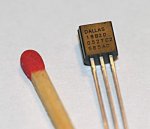and I don't have a thermometer to measure temperatures
Gamesguru: Splutter-I'm near incredulous -did I read this correctly ? NO thermometers at all ? Not even a coin shop offering? Even elementary school kids know & use thermometers. GET ONE PRONTO!
Given this insight I ponder your "accuracy" quest. What is it exactly that you're measuring the temp. of - it's not simply your games PC CPU is it? What temp. range is likely? How were you intending to calibrate against known standards? Thermometer calibration- especially over a significant temp. range- is an immensely technical & costly quest. Here in NZ standards lab. charge US$500 for this, but stand by their calibration charts should legal queries arise-food shipments etc.
At a poor mans level, & aside from the obvious sea level 0°C water freezing & 100°C boiling, the M.Pt determinations of pure substances can assist in calibration. All manner of household pantry goodies can be be used for this -pure sucrose (sugar) melts at 186°C, coconut oil at 26°C, paraffin wax ~ 55°C, beeswax ~62°C. Hours of fun,but don't let any catch fire of course- use a water bath.
Dissolved salts cause a FP depression/BP elevation & the technique has long been used for determining concentrations. Common salt (Sodium Chloride - NaCl) can lower FP temps by at least 9°C. Hence you could use it in reverse, as known solute concentrations should cause freezing at specific temps.
Many forum regulars well know I've thermometers galore (traditional LIG, electrical & electronic), but for educational & modest technical PICAXE use I consider the versatile
DS18B20 the obvious choice. It comes in a "BC547" style TO-92 case, with accuracy ±0.5 °C, & has user configurable resolution up to 12 bits (=0.0625°C). Temperatures from -55°C to +125°C can be measured, with ±0.5°C accuracy from -10°C to +85°C. Of course at ~US$3, it's not as cheap as diode/thermistor/thermocouple approaches, but it's PRODUCTIVE!
Why hence, & echoing postings of others, are you not using the industry standard DS18B20 !?

